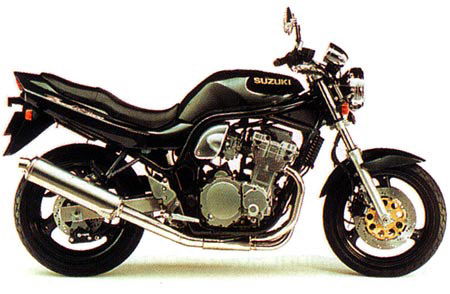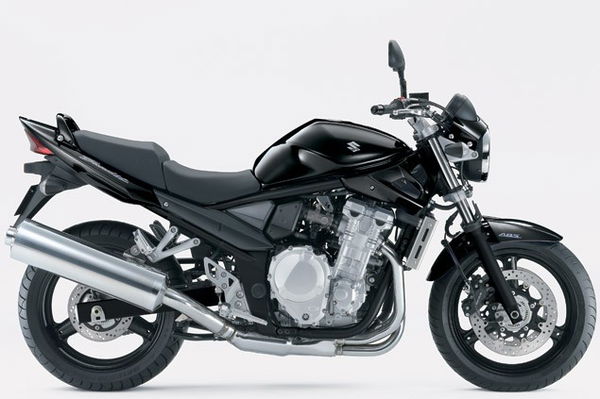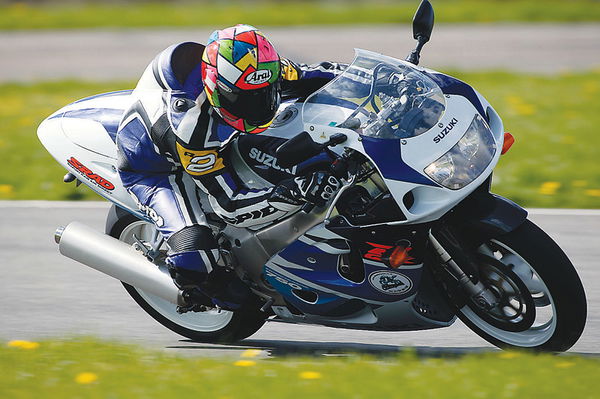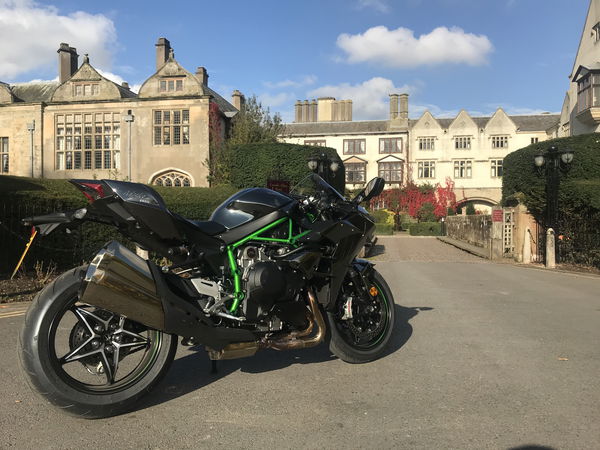Buyer Guide: Suzuki GSF600 Bandit
The ultimate buyer’s guide to the baby Bandit written by the people who actually own the bike...


Click to view: Suzuki GSF600 Bandit owners reviews, specs and image galleries.
Forget the fastest, lightest, latest crowd, Suzuki’s 600 Bandit was never intended to be any of those things. But it’s still a superb bike with a huge following. Its biggest strength is good old fashioned value for money, which is more relevant to most of us than fancy chemical coatings on the fork legs or titanium valve springs. We won’t call the Bandit cheap as that would imply it’d be nasty too, but for the price you pay, you won’t get more bike for the money.
The Bandit wowed everyone when it came out in 1995. Ok it wasn’t the most sophisticated thing – an old engine in a basic chassis – but it looked great, went well, was stacks of fun to ride and the price tag was just £3,999.
Imitation is the most sincere form of flattery and that’s exactly what the other Japanese manufacturers did. Honda’s Hornet 600, Yamaha’s Fazer 600 and even Suzuki’s own SV650 were soon released and were all more advanced that the Bandit, yet it continued to sell in decent numbers and still does so today. It even has some advantages over those competitors anyway: It’s physically the largest and most comfortable, it takes a pillon well and it’s incredibly durable and cheap to run.
Since 1996 it’s always been offered in two versions – a butch looking naked bike and a faired version. Here’s what the Bandit owners think of their bikes.
Suzuki GSF600 Bandit
1995
Engine 599cc, air/oil cooled, dohc, 16 valve, in-line four Power 77bhp @ 10,500rpm Top speed 125mph
Torque 40lbft @ 9,500rpm Dry weight 195kg Seat height 805mm Fuel capacity 19 litres
2000
Engine 599cc, air/oil cooled, dohc, 16 valve, in-line four Power 77bhp @ 10,500rpm Top speed 125mph
Torque 40lbft @ 9,500rpm Dry weight 205kg Seat height 800mm Fuel capacity 20 litres
2005
Engine 656cc, air/oil cooled, dohc, 16 valve, in-line four Power 77bhp @ 10,500rpm Top speed 125mph
Torque 40lbft @ 9,500rpm Dry weight 201kg Seat height 770-790mm Fuel capacity 20 litres
2007
Engine 656cc, liquid cooled, dohc, 16 valve, in-line four Power 85bhp @ 10,500rpm Top speed 130mph
Torque 47lbft @ 8,900rpm Dry weight 215kg Seat height 770-790mm Fuel capacity 19 litres
Running costs and consumables
Fuel consumption is pretty good. Average in our survey was 48mpg while the best was 60 and the worst 25. Average chain life is just under 10,000 miles but this can be halved or doubled depending on how well the owner cares for it. Most owners go for original Suzuki brake pads but 16% use EBC and 3% have opted for Armstrong and a similar number Ferrodo.
Tyres
All Bandit 600s had tyre sizes that are a little outdated. The 150/70-17 rear is ok but some owners recon a wider 160/60-17 works better. It’s the same with the front: originally it’s a 110/70-17 but a handful go for a 120/60-17. It’s less popular that the oversized rear though. Those larger sizes are standard on the 650 versions and work best on that bike.
Bridgestone’s BT020 is the most popular tyre with its successor, the BT021 the next most common choice. Continental Road Attacks, Metzeler Z6 Roadtecs are used by a few but they’re highly rated and both good, modern tyres. Average front tyre life is 6,905 miles with the highest and lowest being 16,000 and 1,500. Rear average is 5,984 with the extremes at 15,000 and 1,500.
Culture
The Bandit’s been a massive seller over the years so there’s loads of bikes out there. That means oodles of new and used spare parts plus there’s a massive range of aftermarket stuff too. There’s specialist shops such as Just Bandits (08702 258743) and Banditmania (01522 871600) and some good owners clubs and websites such as www.banditforum.co.uk so you can get loads of advice from fellow owners and even plug into the social life and go on ride outs too.
Imports
Quite a few 600 Bandits and a handful of 650s are parallel imports. They main problem is most lack the electrical carb heaters (look for the wires) which prevent carb icing in winter. Adding Silkolene Pro FST prevents this. Other signs of an import are KPH speedos, side mounted reflectors and headlights that dip the wrong way plus subtle spec differences like grab handles, centre stands and hard to match colour schemes. Imports are worth 5-10% less.
Owner Case Study: "Mine’s done 60K"
Andy Frost bought his Bandit about three years ago for £850 off eBay.
"It was an import and had 20,000km on the clock. I converted it to miles using one of those little Motrax gearboxes and I’ve used it for all sorts since and it’s up to about 60,000 miles now.
"In all that time the only problem I had was a little bit of water got into the indicator and it kept blowing a fuse. I checked all sorts including trying a different alternator before tracing it to the indicator. Otherwise it’s only had routine maintenance. I replaced the steering head bearings with a mate – it’s not a hard job for a competent mechanic but I was no good at Meccano and we did a fair bit of head scratching. Oh and the seat’s started to rip at the front from having two of us on it but it’s good considering the mileage.
"I had a little break from bikes for a few years but before I had an R6. I loved it but I ended up with carpel tunnel syndrome. The bandit riding position’s much better for me.
"All in all it’s been a cracking little bike. I’ve thought about selling it but I get on it and ride it and it still puts a big grin on my face so I’m keeping it for now. I might get it sprayed up and improve the cosmetics though as the finish isn’t looking brilliant after all hose miles."
What goes wrong
Very little. This is one tough bike and 100,000+ miles is perfectly achievable with regular oil changes. 86% of owners who completed our survey had suffered no problems at all with their bikes. Only one owner who filled in our survey had suffered a major problem. A main bearing went on Stewart Lyons’ 1998 35,000 miles bike – slinging in a used engine was the cheapest, easiest was to sort it.
Although the exhaust looks stainless on all models, the collector is mild steel and can rot.
The oil cooler unions can corrode and break if someone tries to remove them on all models except the water cooled version. Parts alone would cost nearly £500 to fix but Just Bandits do a kit that’ll sort it for half that.
Front brakes discs can seize on their bobbins – check the bobbins are free to turn. Retaining pins in the brake calipers can corrode in place too – again they should be free to move a little and greased regularly to keep them that way.
Steering head bearings can fail as the lower one collects water if left outside. Swing arm bearings can cause problems at higher miles too but both are relatively inexpensive to sort.
A low speed drop on the right hand side can write off a MKI bike as the pillion peg / exhaust bracket is part of the bike’s main frame and can be bent by a modest impact.
Finish
Suzuki aren’t renowned for making the most corrosion-resistant bikes but 67% of owners in our survey are pleased with the way their bikes are standing up to time and the elements. There are some complaints about rust on fasteners, frame welds, the exhaust, the engine, especially the front, swing arm and fork legs.
Tuning and modification
Modifying and Bandits go together like Stella and sovereign rings. Tuning wise few people go beyond an end can. 8% of people in our survey opted for Carbon Can Company, the same percentage went for Scorpion and they all seem pleased with them. Smaller numbers of people opted for other makes – all cost conscious brands such as ART, Fuel and Beowulf. Motad do an all-in-one road legal stainless system which is the sensible choice and sounds good too A smaller front sprocket (14 teeth) is recommended if you want to boost acceleration as the 600s aren’t that torquey at low revs.
The top end from a GSX-R750J or K or GSX750F will go on pretty easily for a bigger increase and it’s not a much bigger job to put the whole engine in. It’s barely worth it though – if you want more poke, sell the 600/650 and get the 1200/1250cc version.
Loads of other modifications are popular. About a third of those with naked bikes have fitted little flyscreens which make a difference but aren’t as good as the fairing, front mudguard extensions and rear huggers feature on about a quarter of all bikes, crash bars or bungs are fairly widespread and while Scottoilers and topboxes are used by a handful of sensible sorts.
Beware anything heavily ‘streetfightered’ it may have been crashed.
Suspension
It’s a weak point to begin with, especially the forks. It was improved on the 650 models but it’s still fairly budget. 9% of owners have fitted jack up kits. It speeds up the steering but puts more weight on the forks so their softness is exaggerated. Some drop the yokes down the forks a few mm to speed up the steering further. Hagon fork springs (020 85026222, £62.50) and fresh oil (15 or 20 weight) make a big difference to the front end. A Hagon shock (£255) transforms the rear. Just Bandits do a suspension package of progressive fork springs, Hagon shock and jack up linkage for £325.
Owner Case Study: "Mine’s a stunting bike"
Stewart Lyons took his 1998 GSF600N’s mileage from 13,000 to 35,000 miles over the last three years. He rode the bike to Holland with his girlfriend on the back twice and crashed it three times. The last accident, about six months ago, was a biggy so he replaced it with a 1250 Bandit for everyday use and has turned his 600 into a stunting machine.
"It’s got a 12 o’clock wheelie bar, a crash cage and a 60 tooth rear sprocket – that’s 15 up on standard. I used to stunt it a bit but I’m doing it more seriously now although there aren’t many places to practice. I do burn outs, wheelies, stoppies – the usual stuff. I can keep the front up in fourth gear and I’m slowly getting the hang of the 12 o’clock position. Unfortunately it’s in bits again right now as I flipped it doing a wheelie and smashed it up a bit.
"I think they’re brilliant bikes. I was 17 when I got the 600 and I wanted a sports bike but I couldn’t afford to insure one. Now I’m glad I got the Bandit. It’s fast enough, handles well, is reliable, cheap and a brilliant all rounder. I used Dunlop D208 tyres and only got about 1000 miles from them but I was stunting a fair bit. I’ve used BT 021s too – they lasted over 2,500 miles but weren’t as grippy when cold. I love Bandits, that’s why I’ve got the 1250 too now."
















